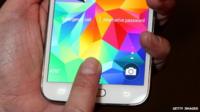 The Apple Watch is of interest to a quarter of people polled in a recent survey. Apple
The Apple Watch is of interest to a quarter of people polled in a recent survey. Apple
Wearable devices remain a niche product, with only 1 in 10 people polled in a recent survey saying they own a smartwatch. But the Apple Watch may prove to be a game changer, if that same survey is any indication.
Of the more than 15,900 adults polled in the US and UK by GlobalWebIndex, 1 in 4 said they're interested in Apple's new wearable, which went on sale last Friday. GWI's online survey, conducted in March and early April, elicited responses from 8,010 Internet users in the UK and 7,890 users in the US aged 16-64.
Apple has entered a brand-new market for itself with its smartwatch. The company hadn't created a new device since it launched the iPad in early 2010, and it needed to try to prove it could still innovate. Competing with a slew of rival devices from Samsung, LG, Sony, Motorola and others, the Apple Watch is designed as a smartwatch, health and fitness tracker and luxury item in an attempt to appeal to a wide audience.
The watch seems to be off to a good start, based on estimates of preorders. On April 13, financial services firm Cowen and Co. estimated that total Apple Watch preorders around the world hit about 1 million units during the first weekend of availability. Piper Jaffray analyst Gene Munster also projected the same number for the opening weekend. On April 27, research firm Slice Intelligence said about 1.7 million watches had been preordered since April 10.
But the Apple Watch is facing the supply and demand issues that typically plague new Apple products. Of the 1.7 million preorders estimated by Slice, only 376,000 units, or 22 percent, had so far been delivered as of Monday, according to the research firm.
During Apple's second-quarter earnings conference on Monday, CEO Tim Cookrefused to reveal any hard sales numbersfor the watch, saying only that customer response has been "overwhelmingly positive." Cook acknowledged that demand for the watch is greater than supply and said Apple is "working hard to remedy that," but he added that he was "generally happy how we're moving on with the ramp."
Based on GlobalWebIndex's first-quarter "GWI Device Summary" report, released Wednesday, demand for (or at least interest in) the watch is healthy among a variety of buyers. Of current smartwatch owners, as many as 70 percent said they're interested in the Apple Watch. The gadget is also an item of interest to 44 percent of iPad owners and 40 percent of iPhone owners.
Among other types of buyers, 44 percent of "early tech adopters" -- people who say that having the latest tech products is very important to them -- are interested in the Apple Watch. The watch has caught the attention of 39 percent of "premium purchasers" -- those who tend to buy the premium version of a product. But even among those considered "price conscious" -- people who say price is more important than the brand name -- 26 percent said they're interested in the Apple Watch.
The Apple Watch is available in three different flavors -- the entry-level Sport version, the midlevel Apple Watch and the luxury Apple Watch Edition. The Sport version starts at $349, the Apple Watch at $549 and the Apple Watch Edition at $10,000.


 Microsoft CEO Satya Nadella at the Build conference Wednesday. CNET
Microsoft CEO Satya Nadella at the Build conference Wednesday. CNET



 Many smartphones can now be unlocked with fingerprints
Many smartphones can now be unlocked with fingerprints
 The Nokia N1 tablet might have a smartphone complement in 2016. Nokia
The Nokia N1 tablet might have a smartphone complement in 2016. Nokia A simple idea. Shoes that are adjustable as the foot grows. Because International/Vimeo screenshot by Chris Matyszczyk/CNET
A simple idea. Shoes that are adjustable as the foot grows. Because International/Vimeo screenshot by Chris Matyszczyk/CNET Beyonce sports an Apple Watch. And it isn't the Sport version. Beyonce.com screenshot by Chris Matyszczyk/CNET
Beyonce sports an Apple Watch. And it isn't the Sport version. Beyonce.com screenshot by Chris Matyszczyk/CNET



